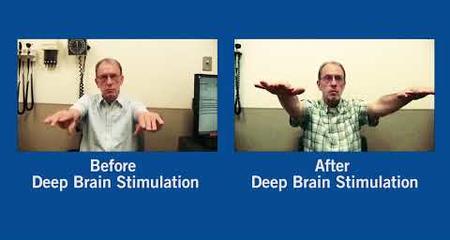There are many types of movement disorders in addition to Parkinson’s disease, Parkinson-plus conditions, ataxia/gait-balance disorders, dystonias and tremor.
Huntington's Disease (HD) and Other Choreas
Huntington’s disease (HD) and other choreas are inherited disorders caused by the degeneration of certain nerve cells in the brain. The disease is genetic. HD causes uncontrolled movements (chorea) and dementia. It usually begins in mid-adulthood and progresses slowly to death. Other names are Huntington disease, Huntington chorea and Huntington’s chorea. More information is available from the Huntington’s Disease Society of America.
Periodic Limb Movement Disorder (PLMD)
This condition is marked by involuntary leg twitching or jerking movements, frequently during sleep, that typically occur every 10 to 60 seconds. The cause is unknown.
Psychogenic Movement Disorders
Patients with these disorders experience increased or decreased movements that originate in the mind. The movements cannot be controlled and are not associated with a known neurological problem.
Restless Leg Syndrome (RLS)
RLS is a neurological disorder with unpleasant sensations in the legs and an uncontrollable urge to move when at rest to relieve these feelings. Learn more about RLS.
Spasticity
Spasticity is a condition in which certain muscles contract continuously, causing stiffness or tightness. Spasticity may interfere with movement, speech and walking. Learn more about our Comprehensive Spasticity Management Program.
Tourette’s Syndrome/Tics
This inherited disorder of the nervous system is characterized by repeated involuntary movements and uncontrollable vocal sounds called tics. Facial tics, such as eye-blinking, nose-twitching, facial grimacing, shoulder shrugging and head/shoulder jerking are the most common symptoms. In a few patients, these tics include using inappropriate words. Symptoms usually appear before age 18, and men are affected more often than women.
Wilson’s Disease
Wilson’s disease is a rare inherited disorder in which excess amounts of copper build up in the body, beginning at birth. Symptoms appear later in life and can include neurological conditions (tremor, rigidity and speech problems), personality/behavioral problems, depression and organ damage. If treatment begins early, symptoms can be greatly reduced, and a person can expect a normal length and quality of life. Without proper treatment, Wilson’s disease is fatal.
Virtual Visits Are Available
Safe and convenient virtual visits by video let you get the care you need via a mobile device, tablet or computer wherever you are. We'll assess your condition and develop a treatment plan right away. To schedule a virtual visit, call 414-777-7700.
More to Explore





